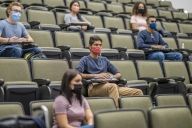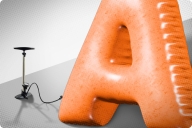You have /5 articles left.
Sign up for a free account or log in.
PROVIDENCE, R.I. -- Fifty years ago, Brown University adopted a "New Curriculum," in which distribution requirements were dropped and course selection was left in the hands of undergraduates who could define their own educational goals. The changes were adopted based on a 400-page report drafted by students and debated by hundreds (most of them students) in lengthy conversations on campus, most of them long outdoor sessions.
The process played out in a time of turmoil at many campuses, an era in which many college leaders agreed to demands to calm things down. Brown is notable, however, in that the curriculum adopted then remains in place. Perhaps realizing the difficulty of calling something that is 50 years old "new," Brown now calls it the "open curriculum." And the university sees the curriculum, and the philosophy of that 50-year-old report, as central to Brown's identity.
On Friday and Saturday, Brown leaders gathered with academics from other colleges -- mostly elite private institutions -- to consider the relevance of the Brown curriculum today. Only a few colleges have adopted similarly open curricula, and some have criticized the curriculum for not sufficiently guiding students to make good educational decisions. But many here see elements of the Brown philosophy -- particularly in viewing undergraduates as active learners, able to make key decisions for themselves -- as relevant for many colleges, including those with much more structure in the curriculum than Brown has.
At the same time, many here expressed fears that innovation may be more difficult today than it was when Brown adopted its changes in 1969, and that society may be less supportive of liberal arts education in any form than it was then.
Rashid Zia, dean of the college at Brown, said that the ideas from 1969 are "enduring" at Brown and noted that they were codified in Brown's official rules and regulations -- even if the statements there seem more rules to prevent the faculty from taking too much control away from students.
The rules state: "At Brown University, the purpose of education for the undergraduate is to foster the intellectual and personal growth of the individual student. The student, ultimately responsible for his or her own development in both of these areas, must be an active participant in framing his or her own education. A central aspect of this development is the relationship of the student with professors and fellow students and with the material they approach together. Structures, rules, and regulations of the university should facilitate these relationships and should provide the student with the maximum opportunity to formulate and achieve his or her educational objectives."
Zia and others here stressed that elements of the report that led to reforms at Brown were not just about requirements -- even if the end of distribution requirements received the most attention.
Indeed parts of the report seem ahead of the curve on other issues. There is a lengthy section on lectures that reads like a call for flipping the classroom (even if online options wouldn't have been available at the time for any part of the flipping).
"If a lecture is dully delivered it can be the deadliest experience a student will encounter in college," the report says. "Some professors, no matter how good they are as scholars and teachers, do not have the abilities necessary to be good lecturers, abilities which may involve such nonscholarly traits as showmanship and humor. Other problems with lectures result when students must note-take to the point where listening, and comprehension, is impossible. Being afraid to miss any of the 'important material' that the professor is presenting, the students write down as much as they possibly can; yet often when students emerge from a lecture with pages of notes, they do not know what the lecture was about."
The report goes on -- in ways that were shocking then, but not today -- to say, "Being a good lecturer is not the equivalent of being a good teacher. It is our belief that these professors should perhaps use other teaching methods, such as the discussion group or the tutorial, or should modify the basic three-lecture-per-week structure of the course. Some possible modifications would be the use of a discussion section … the increased implementation of a question and answer period, or possibly even the increase of office hours."
What Is Student-Focused Innovation Today?
In an era when discussion sections don't count as innovation, what does?
Peter Felten and Sophia Abbot, both from Elon University, led a discussion on viewing students as "partners" in learning.
Felten acknowledged that this is not simple. He recalled a discussion with a faculty member who said, "I have a Ph.D. in organic chemistry and my students do not."
That comment "is fair," Felten said. But he argued that "the job" of teaching organic chemistry is "not for the faculty member to demonstrate her expertise."
By listening to students about the learning process, and making adjustments, more learning will take place -- without sacrificing the substance of what is taught.
Felten and Abbot -- along with Brown students -- discussed Brown programs (far more recent than the curricular reforms of 50 years ago) that have undergraduates assist professors with writing and other tasks in courses. These students are not teaching assistants in the model of many research universities. They don't grade or lead classes. They focus on helping students, one by one, and sharing information with faculty members on what is and isn't working in class. The Brown students said that the experience of doing so made them stronger students.
A topic that came up throughout the conference was about whether ideas in play at Brown, however successful there, could be used elsewhere.
Felten said that some in the audience were probably thinking, "Yeah, you can do this at Brown, where you have brilliant students in small classes. But can you do this at a huge state institution or a community college?"
He also said that many students -- particularly those who may not have attended good high schools -- have been taught to be "receptacles," not active learners able to teach their instructors a thing or two.
All of that's true, he said. But he added that he hoped people with different student populations and different missions consider what they can learn from Brown.
"Context matters," he said, "but that doesn't mean you can't partner with your students. There is not a one-size-fits-all approach to this."
One participant here from a liberal arts college said he loved the ideas behind this role for students, but he stressed that there are many obligations for the colleges. The moment undergraduates are playing a role in class beyond just being a peer, colleges need to be sure they are trained on issues of sexual harassment and discrimination, mental health and more. Just because students may be aware of their duties as students doesn't mean they will know their obligations if they are playing any formal role in class.
Who Gets to Participate?
Brown and other elite colleges are receiving considerable criticism these days for policies and practices many see as favoring the wealthy -- in admissions and the student experience. Brown's president, Christina Paxson, last month announced a review of policies on "fairness" in admissions and in student life.
One presentation here argued that the spirit of student engagement hailed by Brown in celebrating the golden anniversary of curricular reform needs to go further -- into thinking about which students get to participate in engaging programs.
Timothy Eatman, dean of the Honors Living-Learning Community at Rutgers University at Newark, described the academic and nonacademic programming that participants in the program receive. The student population is largely from Newark and low income. Students are from every ethnic and racial group. They include community college transfers. They include the formerly incarcerated.
Eatman argued that you cannot limit innovation in the liberal arts to those who could get into Brown. Those who apply to the program come together in groups of eight or so to work on problems together with a faculty member or someone else observing. Then some are invited for interviews. Standardized testing and other traditional measures of worthiness for an honors program are not used.
"Honors is as diverse as you can get at Rutgers," he said.
Attendees from elite colleges generally said that they admired Eatman's program and saw it as consistent with some of the values of Brown 1969. But these participants also said that they couldn't imagine making decisions about students at their institutions (or being permitted to do so) the way Eatman and his colleagues do.








